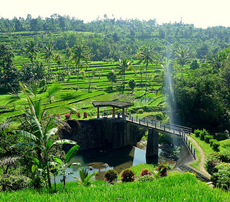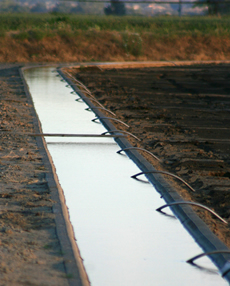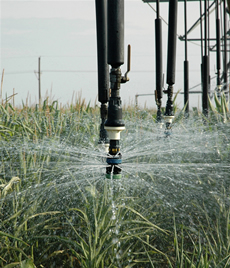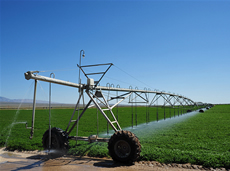Agriculture
Irrigation techniques supply additional water to arid and semiarid horticulture or farming regions where few, if any, crops could otherwise be grown.
Approximately 350 million acres (142 million hectares) of land worldwide are irrigated. In the United States more than 10 percent of the crops, encompassing approximately 50 million acres (20 million hectares), receive water through irrigation techniques; 80 percent of these are west of the Mississippi River.
In countries such as India, Israel, North Korea, and South Korea, more than one-half of food production requires irrigation. From 1950 to 1980, the acreage of irrigated cropland doubled worldwide. Increases since then have been more modest.
Imperial Valley and Israel
An often-cited example of irrigation success is that of the Imperial Valley of Southern California. The valley, more than 5,000 square miles (12,900 square kilometers) in size, was originally considered to be a desert wasteland. The low annual rainfall resulted in a typical desert ecosystem with cacti and other arid-adapted plants and animals.
In 1940, however, engineers completed the construction of the All-American Canal, which carries water 80 miles (130 kilometers) from the Colorado River to the valley. The project converted the Imperial Valley into a fertile, highly productive area where farmers grow fruits and vegetables all year.
Successful agriculture in Israel also requires irrigation. As a result of settlement of the area throughout the twentieth century, large amounts of food must be produced. To fulfill this need, a system of canals and pipelines carries water from the northern portion of the Jordan Valley, where the rainfall is heaviest, to the arid south.
Methods and Technology
Irrigation is an expensive operation that requires advanced technology and large investments of capital. In many cases, irrigation systems convey water from sources hundreds of miles distant.
Such vast engineering feats are largely financed by taxpayers. Typically, water from a river is diverted into a main canal and from there into lateral canals that supply individual farms. From the lateral canals, various systems are used to supply water to the crop plants in the field.
Flood irrigation supplies water to fields at the surface level. Using the sheet irrigation method, land is prepared so that water flows in a shallow sheet from the higher part of the field to the lower part. This method is especially suitable for hay and pasture crops.
Row crops are better supplied by furrow irrigation, in which water is diverted into furrows that run between the rows. Both types of flood irrigation cause soil erosion and loss of nutrients. However, erosion can be reduced in furrow irrigation by contouring the furrows.
Sprinkler irrigation, though costly to install and operate, is often used in areas where fields are ungraded or steeply sloped. Sprinklers are supplied with water by stationary underground pipes or a center pivot system in which water is sprinkled by a raised horizontal pipe that pivots slowly around a pivot point.
A disadvantage of sprinkler irrigation is loss of water by evaporation. In drip irrigation, water is delivered by perforated pipes at or near the soil surface. Because it is delivered directly to the plants, much less water is wasted by evaporation compared to other methods.
Much of the water used in irrigation never reaches the plants. It is estimated that most practices deliver only about 25 percent of the water to the root systems of crop plants. The remaining water is lost to evaporation, supplies weeds, seeps into the ground, or runs off into nearby water ways.
Soil Salinization
As fresh water evaporates from irrigated fields over time, a residue of salt is left behind. The process, called salinization, results in a gradual decline in soil productivity and can eventually render fields unsuitable for agricultural use.Correcting saline soils is not a simple process. In principle, large amounts of water can be used to leach salt away from the soil.
In practice, however, the amount of water required is seldom available, and if it is used, it may waterlog the soil. Also, the leached salt usually pollutes groundwater or streams. One way to deal with salinization is to use genetically selected crops adapted to salinized soils.
Water Resources
As the number of acres of farmland requiring irrigation increases, so does the demand for water. When water is taken from surface streams and rivers, the normal flow is often severely reduced, changing the ecosystems downstream and reducing their biodiversity. Less water becomes available for other farmers downstream, and that situation can lead to disputes over water rights.
In other cases water is pumped from deep wells or aquifers. Drilling wells and pumping water from such sources can be expensive and may lead to additional problems, such as the sinking of land over aquifers. Such land subsidence is a major problem in several parts of the southern and western United States.
 Subsidence in urban areas can cause huge amounts of damage as water and sewer pipes, highways, and buildings are affected. In coastal areas, depletion of aquifers can cause the intrusion of saltwater into wells, rendering them unusable. The federal government spends millions of dollars to repair damage to irrigation facilities each year.
Subsidence in urban areas can cause huge amounts of damage as water and sewer pipes, highways, and buildings are affected. In coastal areas, depletion of aquifers can cause the intrusion of saltwater into wells, rendering them unusable. The federal government spends millions of dollars to repair damage to irrigation facilities each year.
Like many modifications to natural ecosystems, the use of water for irrigation achieves some remarkable but temporary advantages that are complicated by long-term environmental problems. Assessments of total financial costs and environmental impacts are continuously weighed against gains in production.
- Farmland
FarmlandLand used as farmland typically has good agricultural soil and is able to produce food and fiber in an efficient way. Land suitable for agriculture is not evenly distributed throughout the world; it tends to be concentrated in limited areas. In...
- Soil Salinization
Soil SalinizationSoil salinization is a process in which water-soluble salts build up in the root zones of plants, blocking the movement of water and nutrients into plant tissues. Soil salinization rarely occurs naturally. It becomes an environmental...
- Ida May Give $160 Million For Rehabilitation Of Barrages In Sindh
International Development Association (IDA) can possible provide to produce $160 million for Sindh Barrages Improvement Phase-I Project to safeguard the reliable supply of water to regarding a million hectares through the rehabilitation of the Guddu barrage...
- Irrigation: Physical Importance
Irrigation is the artificial supply of water to the plant/crops, according to the free dictionary(http://www.thefreedictionary.com/) irrigation is define as To supply (dry land) with water by means of ditches, pipes, or streams; water artificially. Following...
- Irrigated Agricultures
Agriculture denshering clearing system, and seen as a bus, and some disastrous results due to ecological areas. Population in these areas and along waterways often are dry agriculture practice together. Population density in order to ensure their survival...
Agriculture
Irrigation
 |
| Irrigation |
Approximately 350 million acres (142 million hectares) of land worldwide are irrigated. In the United States more than 10 percent of the crops, encompassing approximately 50 million acres (20 million hectares), receive water through irrigation techniques; 80 percent of these are west of the Mississippi River.
In countries such as India, Israel, North Korea, and South Korea, more than one-half of food production requires irrigation. From 1950 to 1980, the acreage of irrigated cropland doubled worldwide. Increases since then have been more modest.
Imperial Valley and Israel
An often-cited example of irrigation success is that of the Imperial Valley of Southern California. The valley, more than 5,000 square miles (12,900 square kilometers) in size, was originally considered to be a desert wasteland. The low annual rainfall resulted in a typical desert ecosystem with cacti and other arid-adapted plants and animals.
In 1940, however, engineers completed the construction of the All-American Canal, which carries water 80 miles (130 kilometers) from the Colorado River to the valley. The project converted the Imperial Valley into a fertile, highly productive area where farmers grow fruits and vegetables all year.
 |
 |
Successful agriculture in Israel also requires irrigation. As a result of settlement of the area throughout the twentieth century, large amounts of food must be produced. To fulfill this need, a system of canals and pipelines carries water from the northern portion of the Jordan Valley, where the rainfall is heaviest, to the arid south.
Methods and Technology
Irrigation is an expensive operation that requires advanced technology and large investments of capital. In many cases, irrigation systems convey water from sources hundreds of miles distant.
 |
| Methods and Technology |
Flood irrigation supplies water to fields at the surface level. Using the sheet irrigation method, land is prepared so that water flows in a shallow sheet from the higher part of the field to the lower part. This method is especially suitable for hay and pasture crops.
Row crops are better supplied by furrow irrigation, in which water is diverted into furrows that run between the rows. Both types of flood irrigation cause soil erosion and loss of nutrients. However, erosion can be reduced in furrow irrigation by contouring the furrows.
Sprinkler irrigation, though costly to install and operate, is often used in areas where fields are ungraded or steeply sloped. Sprinklers are supplied with water by stationary underground pipes or a center pivot system in which water is sprinkled by a raised horizontal pipe that pivots slowly around a pivot point.
A disadvantage of sprinkler irrigation is loss of water by evaporation. In drip irrigation, water is delivered by perforated pipes at or near the soil surface. Because it is delivered directly to the plants, much less water is wasted by evaporation compared to other methods.
Much of the water used in irrigation never reaches the plants. It is estimated that most practices deliver only about 25 percent of the water to the root systems of crop plants. The remaining water is lost to evaporation, supplies weeds, seeps into the ground, or runs off into nearby water ways.
Soil Salinization
 |
| Irrigation technology |
In practice, however, the amount of water required is seldom available, and if it is used, it may waterlog the soil. Also, the leached salt usually pollutes groundwater or streams. One way to deal with salinization is to use genetically selected crops adapted to salinized soils.
Water Resources
As the number of acres of farmland requiring irrigation increases, so does the demand for water. When water is taken from surface streams and rivers, the normal flow is often severely reduced, changing the ecosystems downstream and reducing their biodiversity. Less water becomes available for other farmers downstream, and that situation can lead to disputes over water rights.
In other cases water is pumped from deep wells or aquifers. Drilling wells and pumping water from such sources can be expensive and may lead to additional problems, such as the sinking of land over aquifers. Such land subsidence is a major problem in several parts of the southern and western United States.

Like many modifications to natural ecosystems, the use of water for irrigation achieves some remarkable but temporary advantages that are complicated by long-term environmental problems. Assessments of total financial costs and environmental impacts are continuously weighed against gains in production.
- Farmland
FarmlandLand used as farmland typically has good agricultural soil and is able to produce food and fiber in an efficient way. Land suitable for agriculture is not evenly distributed throughout the world; it tends to be concentrated in limited areas. In...
- Soil Salinization
Soil SalinizationSoil salinization is a process in which water-soluble salts build up in the root zones of plants, blocking the movement of water and nutrients into plant tissues. Soil salinization rarely occurs naturally. It becomes an environmental...
- Ida May Give $160 Million For Rehabilitation Of Barrages In Sindh
International Development Association (IDA) can possible provide to produce $160 million for Sindh Barrages Improvement Phase-I Project to safeguard the reliable supply of water to regarding a million hectares through the rehabilitation of the Guddu barrage...
- Irrigation: Physical Importance
Irrigation is the artificial supply of water to the plant/crops, according to the free dictionary(http://www.thefreedictionary.com/) irrigation is define as To supply (dry land) with water by means of ditches, pipes, or streams; water artificially. Following...
- Irrigated Agricultures
Agriculture denshering clearing system, and seen as a bus, and some disastrous results due to ecological areas. Population in these areas and along waterways often are dry agriculture practice together. Population density in order to ensure their survival...


